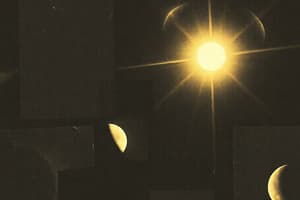Podcast
Questions and Answers
What primarily determines the size of a shadow?
What primarily determines the size of a shadow?
- The shape of the screen
- The color of the object
- The brightness of the light
- The distance from the light source (correct)
Which statement accurately describes a characteristic of light?
Which statement accurately describes a characteristic of light?
- Light only travels in curved lines.
- Light cannot be reflected.
- Light can only travel through transparent objects.
- Light travels in straight lines. (correct)
What happens when light passes from air into water?
What happens when light passes from air into water?
- It speeds up and travels in a straight line.
- It loses its brightness completely.
- It bends due to refraction. (correct)
- It reflects back into the air.
What type of image does a plane mirror produce?
What type of image does a plane mirror produce?
Which term describes an object that allows no light to pass through it?
Which term describes an object that allows no light to pass through it?
What is responsible for the twinkling of stars?
What is responsible for the twinkling of stars?
Which component of the human eye is responsible for focusing light onto the retina?
Which component of the human eye is responsible for focusing light onto the retina?
What occurs when white light passes through a prism?
What occurs when white light passes through a prism?
Why is light essential for vision?
Why is light essential for vision?
How does light behave when it reflects off a surface?
How does light behave when it reflects off a surface?
Flashcards
Light source
Light source
An object that emits light.
Opaque object
Opaque object
An object that doesn't allow light to pass through it.
Shadow
Shadow
Dark area formed when light is blocked by an object.
Reflection of light
Reflection of light
Signup and view all the flashcards
Refraction of light
Refraction of light
Signup and view all the flashcards
Transparent materials
Transparent materials
Signup and view all the flashcards
Translucent materials
Translucent materials
Signup and view all the flashcards
Luminous object
Luminous object
Signup and view all the flashcards
Non-luminous object
Non-luminous object
Signup and view all the flashcards
Virtual image
Virtual image
Signup and view all the flashcards
Study Notes
Light Sources
- Light sources can be natural (e.g., sun, stars) or artificial (e.g., lamps, flashlights).
- Luminous objects produce their own light, while non-luminous objects reflect light from a source.
- Light travels in straight lines, which is demonstrated by the formation of shadows.
Shadows
- A shadow is a dark area formed when an opaque object blocks the path of light.
- The size and shape of a shadow depend on the size and shape of the object and the position of the light source.
- The closer the object is to the light source, the larger the shadow.
- The closer the object is to the screen, the smaller the shadow.
- The shape of the shadow is similar to the shape of the object casting the shadow.
Properties of Light
- Light travels in straight lines.
- Light can be reflected.
- Light can be refracted (bent).
Reflection of Light
- Reflection is the bouncing back of light rays when they hit a surface.
- The angle of incidence is equal to the angle of reflection. This is known as the law of reflection.
- A plane mirror produces a virtual image that appears to be behind the mirror.
- The image formed is the same size as the object, upright, and laterally inverted (left-right reversed).
Refraction of Light
- Light bends when it passes from one medium to another (e.g., from air to water). This is called refraction.
- The amount of bending depends on the density of the media.
- Refraction is responsible for phenomena like the apparent bending of a stick in water, and the twinkling of stars.
- A prism can separate white light into its constituent colors (red, orange, yellow, green, blue, indigo, violet).
Uses of Light
- Light is essential for vision.
- Light allows us to see objects and their surroundings.
- Light is used in various applications, such as photography, lamps, screens, and many technological processes.
Light and Our Eyes
- The human eye has a lens that helps focus light onto the retina.
- The retina converts light into electrical signals that are sent to the brain.
- The brain interprets these signals as images.
- Our eyes can adapt to different light levels.
Important Terms
- Opaque: Objects that do not allow light to pass through them.
- Transparent: Objects that allow light to pass through them easily.
- Translucent: Objects that allow some light to pass through them, but scatter the light.
- Luminous: Objects that produce their own light.
- Non-luminous: Objects that do not produce their own light.
Simple Experiments
- Using a torch, an object, and a screen to observe shadows and explore how size and position affect the shadow's characteristics.
- Observing reflection using a mirror and understanding the law of reflection.
- Observing refraction using a glass of water and a pencil to see how light bends when passing through the water.
Studying That Suits You
Use AI to generate personalized quizzes and flashcards to suit your learning preferences.




